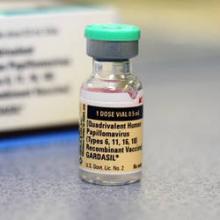A clinical reviewer for the Food and Drug Administration Center for Biologics Evaluation and Research sees no problem with using an anal dysplasia end point, or extrapolating male data to females, to support approval of Merck’s human papillomavirus vaccine Gardasil for prevention of anal cancer.
Nevertheless, the agency is asking an advisory committee for input on these very issues at a Nov. 17 meeting, and a later review by the Centers for Disease Control and Prevention’s Advisory Committee on Immunization Practices panel may be key for utilization and reimbursement.
In his clinical review, medical officer Dr. Jeffrey Roberts of the Center for Biologics Evaluation and Research (CBER) said available data support approval of Gardasil for males and females aged 9-26 years, to prevent anal intraepithelial neoplasia (AIN) and anal cancer caused by human papillomavirus types 6, 11, 16, and 18, according to a briefing document for the meeting, which was posted by the FDA more than 2 weeks earlier than usual.
The session will mark the third time the FDA’s vaccines advisory committee has reviewed Merck’s quadrivalent HPV vaccine. To date, each meeting has amounted to a slam dunk for the company, and the FDA’s briefing documents on the anal cancer indication suggest Gardasil’s third trip before the committee is unlikely to be much different.
While a Gardasil anal cancer indication appears headed for a committee endorsement and FDA approval, a less certain question is whether the Centers for Disease Control and Prevention’s (CDC’s) Advisory Committee on Immunization Practices (ACIP) will find the data persuasive enough to recommend routine vaccination of males. ACIP’s deliberations are important to Merck for purposes of securing widespread use and reimbursement of Gardasil in boys and men.
FDA Cautious on HPV Vaccines
In May 2006, the FDA’s vaccines committee unanimously supported Gardasil’s safety and efficacy for its initial indication: the prevention of cervical cancer and precancerous lesions in girls and women.
In September 2009, seven of eight committee members said the vaccine was efficacious and safe for preventing genital warts in males 9-26 years old.
However, panelists raised concerns about several issues, including evidence on the duration of the vaccine’s effect, clarity about its effect in situations of preinfection with HPV types 6 and 11, and the need for data on a larger group of men.
The FDA’s decision to hold three advisory committee meetings on Gardasil could be viewed as a desire for outside input due to the politically sensitive issues involved in vaccinating adolescents and teenagers to prevent sexually transmitted conditions. The agency also sought advisory panel review for licensing of GlaxoSmithKline PLC’s bivalent HPV vaccine Cervarix, although much of the committee’s focus was on the formulation’s novel adjuvant.
Gardasil is currently approved for prevention of cervical, vulvar, and vaginal cancers and associated precancerous lesions in girls and women aged 9-26 years, as well as for the prevention of genital warts in males and females aged 9-26 years.
Notably, the FDA has not sought advisory committee review of Merck’s bid to expand the vaccine’s use to women aged 27-45 years. The company has received two "complete response" letters for this population, and is waiting to hear back from the FDA after submitting 48-month, end-of-trial data from the FUTURE III study in 3,817 older women.
Males-Only Substudy Equals No Female Data
Merck’s supplemental biologics license application for the AIN/anal cancer indication was submitted in February, and the company expects a regulatory decision by the end of 2010.
The pivotal data come from a 602-patient substudy of men who have sex with men (MSM) and were part of the 4,065-subject trial that supported approval of the genital warts indication for males. The MSM population was targeted because of high rates of anal HPV infection and disease that result from behavior-associated risk factors in this group, Merck said in its briefing material for the committee.
Gardasil was 78% efficacious in preventing the primary composite end point – HPV 6/11/16/18-related AIN of any grade and anal cancer. Efficacy fell to 75% in preventing advanced dysplasia involving cases of AIN grade 2 or higher.
CBER is convening the Vaccines and Related Biological Products Advisory Committee "to discuss the efficacy data, particularly use of the AIN end point to assess efficacy in the prevention of anal cancer," Dr. Roberts said in his review. "In addition, because the applicant is requesting that the AIN and AC [anal cancer] indication be extended to females based on clinical data in males only, CBER is seeking input on this approach to the female indication."

